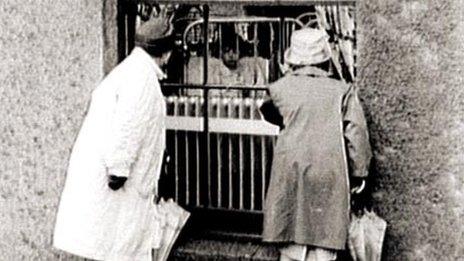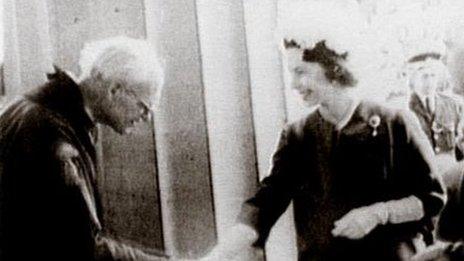Aberdeen's typhoid outbreak remembered 50 years on
- Published
The typhoid outbreak happened in Aberdeen in 1964
"I said 'dinna cremate me! I want to be buried!'"
Sheena Blackhall was a 16-year-old schoolgirl when Aberdeen was brought to its knees by the largest typhoid outbreak in recent British history 50 years ago.
More than 500 people of all ages had to be quarantined in hospital.
The infection was eventually traced back to a single tin of Argentinean corned beef sold in a supermarket.
It happened in the summer of 1964, and led to speculation across the country of many deaths.
In reality, and somewhat remarkably, the outbreak was contained without a single related death.
Most patients spent many weeks in hospital until they were allowed home.
Ms Blackhall told BBC Scotland: "The GP that we had had been in a Japanese prisoner of war camp so he knew right away that I had typhoid and phoned for an ambulance, by which time I had a very high temperature and I was delirious.
"I remember nothing about this but apparently when they took me down the stairs I said 'dinna cremate me! I want to be buried!' - which upset everybody.
"When I got to the hospital, racing through the streets in the ambulance, the men in the white coats were there - that was the doctors - but I, still delirious, thought it was seagulls.
"I thought I was being attacked by giant seagulls and I very quickly got an injection in my posterior and that knocked me out cold.

Relatives would interact with children through windows
"When I came round, I was in the ward and was there for three months.
"It was pretty dire to start with because we were getting massive doses of antibiotics, so we were on 16 things like horse pills a day.
"One girl had a violent reaction to the high doses of antibiotics. She couldn't stand anything next to her skin so they had a cage over her body, with blankets over the top so she wasn't cold.
"The men came from London - they were dressed like something out of Star Wars, completely suited up - to take photographs of her.
"We got mens' pyjamas which were far too big for us and drowned us. We needed safety pins to hold them up because it was the best diet I was ever on. I lost about two to three stone during the time I was in hospital."
'Folk were terrified'
Asked what the experience was akin to, she said: "Very much like being a bumble bee in a jam jar. You know, as children do when they trap a little bumble bee and they just put the lid on and shake it up and down.
"It's exactly how people were treated during the time of the plague in the city. Folk were terrified of getting it.
"You couldn't get out. You were locked in. I suppose it must be what people would be like in Craiginches [Prison]. You just couldn't get out.
"They [relatives] had to stand outside, it didn't matter what the weather was like. The windows were not open because of the fear of contagion.
"The terror was so great that the milkman would leave bottles of milk at the bottom step. People wouldn't come up to my parents door because they were terrified they would catch it."

The Queen raised morale with a visit to Aberdeen
She said her family's bus firm was "finished" as, when word got out she had typhoid, people cancelled journeys "left, right and centre", adding: "Many businesses in the city were the same."
A visit by The Queen helped end some of the stigma placed on the city and its residents by the infection.
An inquiry into the outbreak later found that a large can of Argentinean corned beef had been sold sliced from the cold meat counter of the William Low supermarket.
The can had been cooled in Argentina using untreated water from a river.
The typhoid organism was assumed to have entered the meat through a small hole in the seam of the can.
It was then passed on to anyone who bought the corned beef, or other products which had come into contact with the shop's meat slicer.
The media attention helped raise the importance of cleanliness and hygiene.
Hygiene lessons from the Aberdeen typhoid outbreak are still relevant today.
Prof Hugh Pennigton, the renowned bacteriologist, said it was an "enormous" outbreak.
'Big impact'
He said: "We thought by 1964 we'd seen the back of bugs like typhoid and these horrible outbreaks. So it was a very important event in that respect.
"We hadn't been seeing lots of cases in the UK at all, particularly in Aberdeen. We had very good medical set up, pure water, all these sorts of things for a long time, so it took everybody by surprise."
He explained: "It had a big impact on Aberdeen itself, not just on the people who fell ill who were all out into hospital for long periods of time, it stressed the NHS to the limit.
"The idea was to stop them infecting other people.
"I think we learned lots of lessons."
For Sheena Blackhall, it is 50 years since a harrowing episode of her life that she and the others who were affected are unlikely to ever forget.